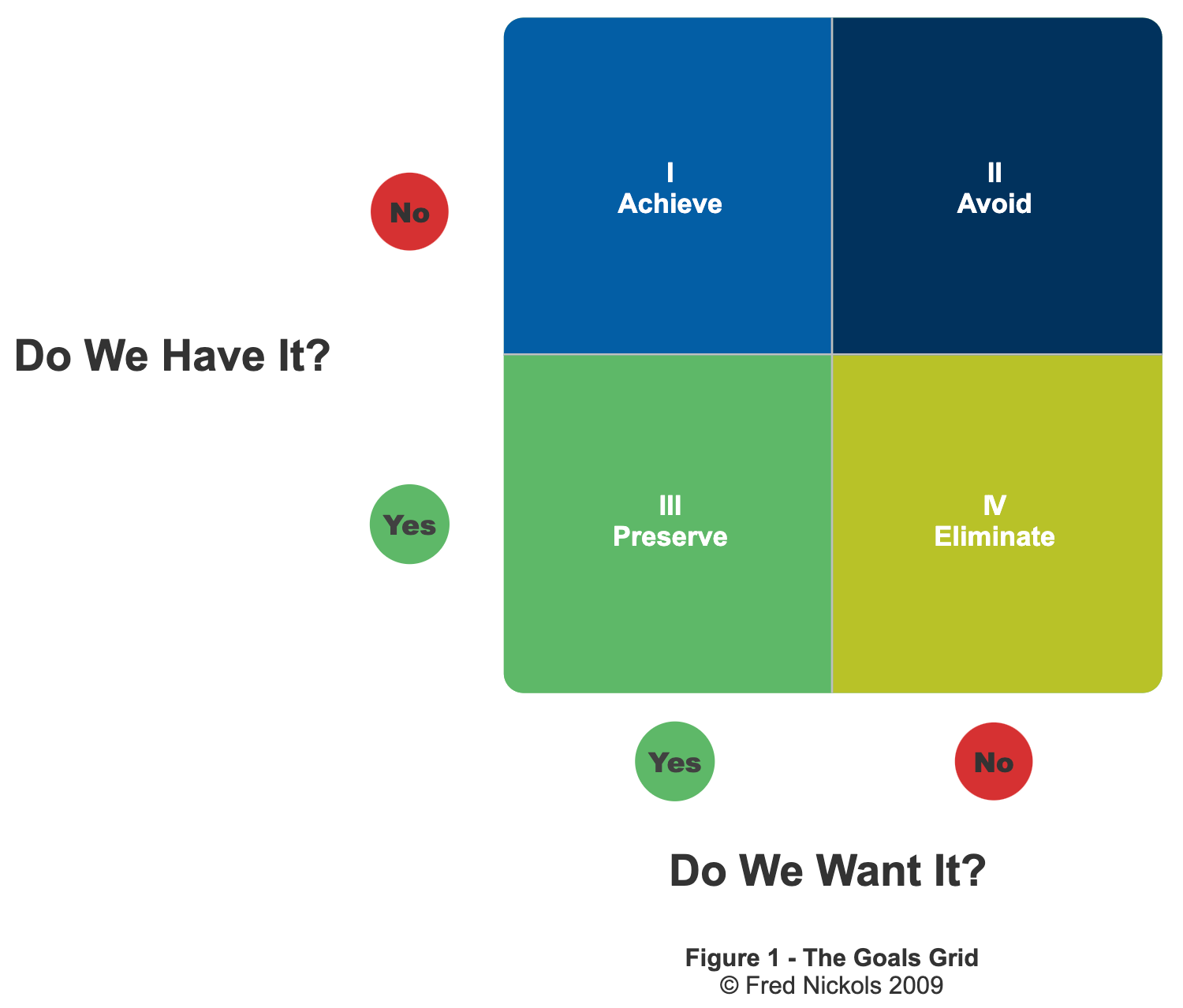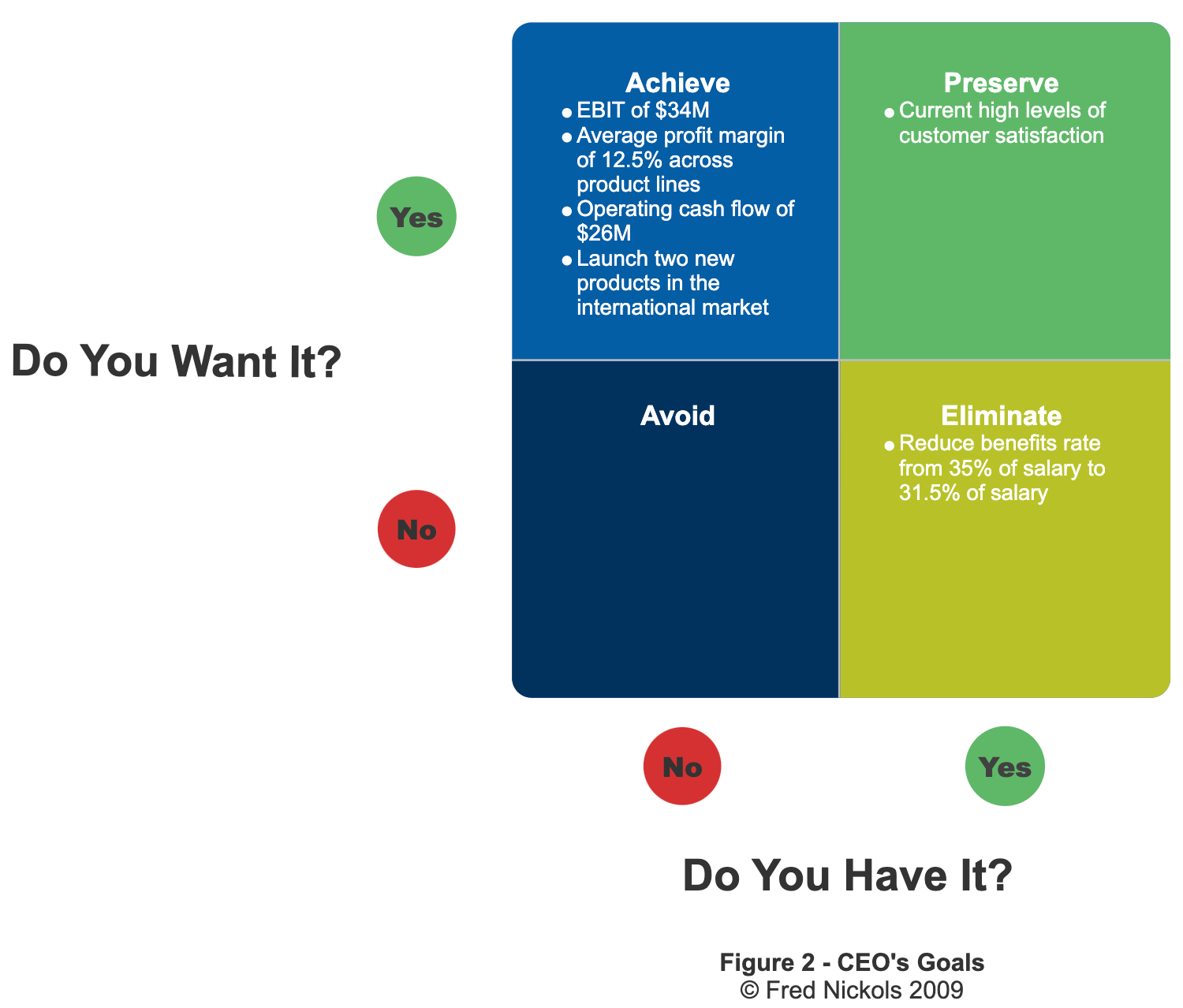A Strategic Planning Tool: The Goals Grid
Written by Fred Nickols
One of the major products of any strategic planning process is a set of strategic goals and objectives. In this regard, the Goals Grid (see Figure 1) is a useful and flexible strategic planning tool. Below are listed some of its many uses:
- prompt and facilitate discussion aimed at setting goals and objectives;
- document the results of such discussions;
- provide a visual array and means of organizing goals and objectives;
- classify, clarify and analyze an existing set of goals and objectives
The purpose of this article is to illustrate the flexibility, utility and value of the Goals Grid by describing some of the different ways in which it can be used.

As the structure of the Goals Grid suggests, there are four basic categories of goals and objectives: Achieve, Preserve, Avoid and Eliminate. This structure can be used as a framework for generating goals and objectives. Here are two different sets of questions that could be used for this purpose.
From a strategic perspective:
- What is it we want and don't have? (Achieve)
- What is it we have and want to keep? (Preserve)
- What is it we don't have and don't want? (Avoid)
- What is it we have and don't want? (Eliminate)
A similar yet simpler set of questions might take this form, again from a strategic perspective:
- What do we want to achieve?
- What do we want to preserve?
- What do we want to avoid?
- What do we want to eliminate?
The previous sets of questions help in setting or generating goals and objectives. Another use of the Goals Grid is in clarifying goals and objectives. Suppose, for example, that as part of your tentative strategic plan you are contemplating a reorganization of your division, department or company. The structure of the Goals Grid can be used to formulate a set of questions useful in clarifying the goals and objectives of such a reorganization. Consider the following list:
- As a result of the reorganization, what do we hope to achieve?
- In the course of reorganizing, what might we want to preserve?
- In the course of reorganizing, what do we want to make sure we avoid?
- What, if anything, are we hoping the reorganization will eliminate?
The preceding set of questions shows how the Goals Grid can be used to clarify the intended outcomes of a particular course of action or other initiative.
Here is a good place to make a key point: You are not bound by the questions presented here. The usefulness of the Goals Grid as a tool lies in the ease with which you can adapt it to fit your circumstances. To illustrate, consider again, the reorganization issue. A different set of questions might be as follows:
- What will the reorganization give us that we don't already have?
- After the reorganization is complete, what do we want to make sure is still with us?
- What do we not have now that we don't want after the reorganization?
- What is the reorganization going to get rid of?

In other words, play with the framework of the Goals Grid and use it to formulate questions in different ways, using different words in order to examine the issue from different perspectives.
A third use of the Goals Grid is as a check on the comprehensiveness and the distribution of a given set of goals and objectives. You can assign each objective to the appropriate quadrant. When finished, you have a visual array of your goals and objectives which you can search for patterns.
Figure 2 displays the actual goals set by the CEO of a $500M company. There are some pronounced patterns. Except for customer satisfaction, all the goals are financial in nature. There is nothing in the Avoid quadrant and only one each in the Preserve and Eliminate quadrants. Clearly, the CEO's goals cluster in the Achieve quadrant. Does this mean the CEO sees no threats to be avoided or has something been overlooked? All but one of the goals are financial in nature. Is there nothing of an operational nature or do those goals fall under the aegis of the COO? These kinds of patterns shed useful light on a set of goals and objectives. They draw attention to the nature of the goals and objectives, they expose areas that have been overlooked and they raise questions about empty quadrants.
Finally, you can use this framework alone or in a group setting. It can be used to facilitate discussion and to record and communicate the results of such discussions. Individuals can use it separately and then compare, discuss and integrate their individual efforts. A consulting colleague of mine who uses the Goals Grid on a regular basis as part of a facilitated strategic planning process describes his use of it as follows:
"The process I use to facilitate groups of 12 or more people is to have smaller groups of 3 or 4 participants discuss and arrive at the top 3 responses for each of the quadrants using the basic questions: What do we want to achieve? What do we want to preserve? What do we want to avoid? What do we want to eliminate?"
"Using one quadrant at a time, I ask each group to present one response and take turns among the groups until they have identified all the responses that come to mind for a given quadrant. Duplication is prevented by asking each small group to give a response that is different from any response already listed. Often I ask the groups how many of them had the response just voiced by a different group. When the quadrant is populated the group discusses the list. The process is repeated for each quadrant. The result is a populated Goals Grid that has great utility for a board struggling to make decisions about their organization."
"I've found that the question, 'What do we want to eliminate?' is very effective in triggering group discussions of issues that exist. The question, 'What do we want to avoid?' focuses the group's discussion to anticipated issues and/or threats to the organization."
In short, as I said at the outset, the Goals Grid is a very flexible and easy to use tool for setting, clarifying and analyzing goals and objectives (as well as issues) as part of the strategic planning process. If you'd like to experiment with using the Goals Grid, you will find a blank version in SmartDraw.
About the Author: My name is Fred Nickols. I am a writer, an independent consultant and a former executive. Visual aids of one kind or another have played a central role in my work for many years. My goals in writing for SmartDraw's Working Smarter blog are to: (1) provide you with some first-rate content you can't get anywhere else, (2) illustrate how important good visuals can be in communicating such content and (3) illustrate also the critical role visuals can play in solving the kinds of problems we encounter in the workplace.